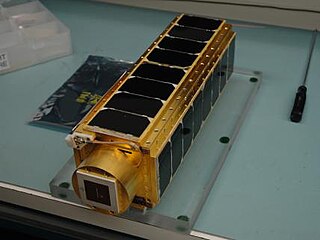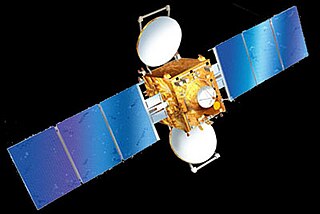
PharmaSat was a nanosatellite developed by NASA Ames Research Center which measured the influence of microgravity upon yeast resistance to an antifungal agent. As a follow on to the GeneSat-1 mission, the Ames Small Spacecraft Division conducted the PharmaSat mission in collaboration with industry and local universities.

OPS 0855, also designated OV4-3, was an American boilerplate Manned Orbiting Laboratory spacecraft launched in 1966. It was flown to demonstrate the launch configuration for future MOL missions. A number of research payloads, designated Manifold, were carried on board, which were intended to operate for 75 days. However, the spacecraft ceased operations after just 30. It was built from a decommissioned HGM-25A Titan I first stage oxidizer tank, bolted to a Transtage. It was part of the MOL and Orbiting Vehicle projects.

Progress M-03M, identified by NASA as Progress 35P, was a Progress spacecraft used by the Russian Federal Space Agency to resupply the International Space Station (ISS).

NanoSail-D2 was a small satellite built by NASA's Marshall Space Flight Center and Ames Research Center to study the deployment of a solar sail in space. It was a three-unit CubeSat, measuring 30×10×10 centimetres (11.8×3.9×3.9 in) with a mass of 4 kilograms (8.8 lb). Its solar sail had an area of 10 square meters (110 sq ft), and was deployed in around five seconds.

INSAT 3E is a defunct communication satellite built by Indian Space Research Organisation. It was launched on September 28, 2003 from the European Space Agency's spaceport in French Guiana on board the Ariane rocket. The satellite had a launch mass of 2750 kilograms. It is the 4th satellite launched in the INSAT-3 series for INSAT. It was designed for providing high-speed communication, Television, VSAT & Tele-education services and was an important landmark in Indian Space Programme.
Kosmos 2176 was a Russian US-K early warning satellite which was launched in 1992 as part of the Russian Space Forces' Oko programme. The satellite was designed to identify missile launches using optical telescopes and infrared sensors.
SES-2 is a communications satellite operated by SES World Skies. It was launched on 21 September 2011 on an Ariane 5 ECA vehicle, alongside the Arabsat-5C satellite. It entered into commercial service on 27 October 2011 in the 87° West orbital location.

Kosmos 2430 was a Russian US-K missile early warning satellite which was launched in 2007 as part of the Russian Space Forces' Oko programme. The satellite was designed to identify missile launches using optical telescopes and infrared sensors.
Kosmos 2368 was a Russian US-K missile early warning satellite which was launched in 1999 as part of the Russian Space Forces' Oko programme. The satellite was designed to identify missile launches using optical telescopes and infrared sensors.
Kosmos 2351 was a Russian US-K missile early warning satellite which was launched in 1998 as part of the Russian Space Forces' Oko programme. The satellite was designed to identify missile launches using optical telescopes and infrared sensors.
Kosmos 2342 was a Russian US-K missile early warning satellite which was launched in 1997 as part of the Russian Space Forces' Oko programme. The satellite was designed to identify missile launches using optical telescopes and infrared sensors.
Kosmos 2340 was a Russian US-K missile early warning satellite which was launched in 1997 as part of the Russian Space Forces' Oko programme. The satellite was designed to identify missile launches using optical telescopes and infrared sensors.
Kosmos 903 was a Soviet US-K missile early warning satellite which was launched in 1977 as part of the Soviet military's Oko programme. The satellite was designed to identify missile launches using optical telescopes and infrared sensors.
Kosmos 2467 is one of a pair of Russian military communications satellites which were launched in 2010 by the Russian Space Forces. It was launched with Kosmos 2468 and a Gonets-M civilian communication satellite.
Kosmos 2468 is a Russian military communications satellite which was launched in 2010 by the Russian Space Forces. It was launched with Kosmos 2467 and a Gonets-M civilian communication satellite.
TeikyoSat-3 was a technology demonstrator and microbiology microsatellite intended to research the slime mold life cycle in space. Specifically, the effects of ionizing radiation are or special concern. The primary mission is expected to be finished in 10–20 days with completion of first life cycle of slime mold in space, but mission can be extended to study evolutionary adaptations for a maximum of 1 year. Also, a novel thermal control system capable of keeping a stable temperature in small (20 kg) microsatellite bus is being tested. The satellite is made in Teikyo University (Japan) and has a size of 320x320x370mm. The microsatellite microbiology experimental platform is intended to address issues with cost and uncertain future of experiments based on International Space Station. TeikyoSat-3 also transmit its telemetry uncoded at 473.45 MHz, and any amateur radio operator is welcome to share downlink data.
ITF-1, also known as Yui, was an amateur radio cubesat built by Tsukuba University of Japan.
Advanced Land Observing Satellite 2, also called Daichi 2, is a 2-ton Japanese satellite launched in 2014. Although the predecessor ALOS satellite had featured 2 optical cameras in addition to 1.2 GHz (L-band) radar, ALOS-2 had optical cameras removed to simplify construction and reduce costs. The PALSAR-2 radar is a significant upgrade of the PALSAR radar, allowing higher-resolution spotlight modes in addition to the 10m resolution survey mode inherited from the ALOS spacecraft. Also, the SPAISE2 automatic ship identification system and the Compact Infra Red Camera (CIRC) will provide supplementary data about sea-going ships and provide early warnings of missile launches.

Laser communication in space is free-space optical communication in outer space.







